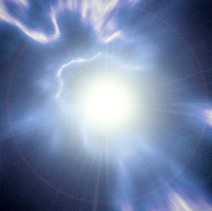One of the challenges of modern physics is to reconcile quantum mechanics and relativity. So far, quantum theories of gravity have never been tested experimentally. Loop quantum gravity, one of these theories, might be testable after all.
The key to this experimental test comes from black holes: when they evaporate, the radiation they emit could reveal footprints of loop quantum gravity. Aurélien Barrau from Laboratoire de Physique Subatomique et de Cosmologie, Grenoble, France, and colleagues suggest that primordial black holes should reveal two distinct loop quantum gravity signatures.
The scientists used Monte-Carlo simulations to check if they could discriminate those signatures (peaks at certain energy levels) and those of the Hawking radiation emitted by evaporating black holes. According to their results, if the number of black holes is big enough, or if the error on energy reconstruction is small enough, then the signatures should be identifiable.
While this might be the first experimental test for a quantum theory of gravity, there are still a few issues… Indeed, black hole evaporation has never been observed, thus remaining hypothetical, at least for the time being. Another detail, and it is quite a big one in ny opinion, is the recent result obtained by ESA’s Integral gamma-ray observatory: if there is any “quantum graininess” of space, it is so small that it simply rules out… loop quantum gravity.
Finally, the researchers are also investigating the possibility of finding loop quantum gravity signatures in the cosmic microwave background. This would have the advantage of being testable right away, or in the near future. Anyway, unless Integral’s results are wrong or scientists “tweak” loop quantum gravity, looking for such signatures might just be like trying to prove Earth is flat…
Reference
A. Barrau, et al. “Probing Loop Quantum Gravity with Evaporating Black Holes.” Physical Review Letters 107, 251301 (2011).DOI: 10.1103/PhysRevLett.107.251301

